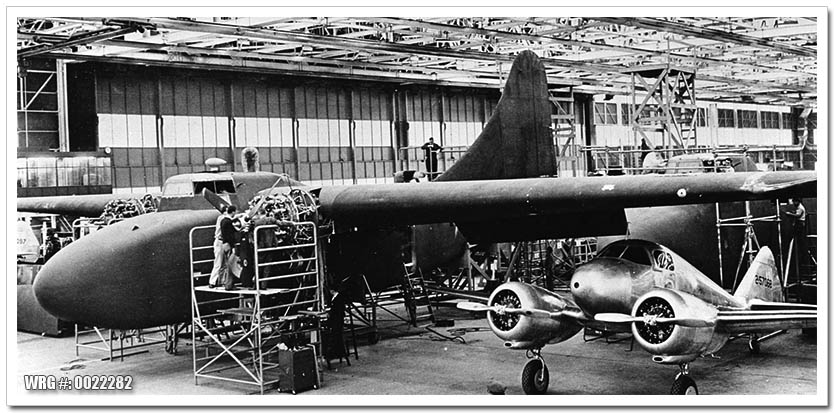U.S.A.A.F. RESOURCE CENTER > TRAINERS > AT-9 JEEP > PREVIOUS PAGE
CURTISS-WRIGHT AT-9 JEEP
Operational History
The first prototype Model 25 flew in 1941 and the production version entered service as the AT-9 in 1942. Named the "Fledgling" by Curtiss-Wright, it commonly became known as the "Jeep" in the United States Army Air Forces (USAAF). The prototype CW-25 had a fabric-covered steel tube fuselage and fabric-covered wings and tail units, but production AT-9s were of stressed metal skin construction.

Curtiss-Wright production line for the C-76 Caravan in 1943.
A Curtiss AT-9A Jeep trainer (42-57068) is nestled under the Caravan's wing.
[Source: USAAF Photo]
The AT-9 was purposely designed to be less stable and proved to be difficult to fly or land, which made it particularly suitable for teaching new pilots to cope with the demanding flight characteristics of a new generation of high-performance, multi-engined aircraft such as the Martin B-26 Marauder and Lockheed P-38 Lightning.
A total of 491 AT-9s were built before production ended and a new production run of 300 of the generally similar AT-9A commenced.
Because of its difficult flying characteristics the AT-9 was not offered for sale to civilians after the war, although many non-flying examples were given to ground schools for training purposes.
Sources:
Wikipedia
U.S.A.A.F. RESOURCE CENTER > TRAINERS > AT-9 JEEP > PREVIOUS PAGE

